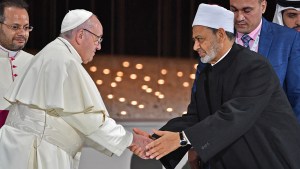On Monday, September 30, the Permanent Observer Mission of the Holy See to the United Nations celebrated a Mass in recognition of its 60 years of presence at the UN. The celebration was held at the Church of the Holy Family, located just blocks from the United Nations building. Presiding was Cardinal Pietro Parolin, the Pope’s Secretary of State. Archbishop Gabriele Giordana Caccia, Apostolic Nuncio and the current Permanent Observer, acted as a concelebrant with clergy from the Archdiocese of New York. About 250 diplomats and UN observers, along with staff members and family members, were also present.
Origins of the Mission
The origins of the Holy See’s presence at the UN date back to the early 1960s. Author Victor Gaetan, in the bookGod’s Diplomats: Pope Francis, Vatican Diplomacy, and America’s Armageddon, explains that UN Secretary-General U Thant, a practicing Buddhist, advocated for the Vatican to have a place at the table. The former Burmese representative to the UN, who was elected secretary-general after the tragic death of Dag Hammarskjöld, felt that communities of faith should be UN allies in the effort to foster a middle path between the superpowers.
“He also admired the stance of impartiality taken by the Holy See, an attitude personified by Pope John XXIII’s role during the Cuban missile crisis, which Thant was in the thick of settling,” Gaetan writes.
The Holy See is not a “full member” at the UN. Because it wants to maintain neutrality in the political sphere, it chose to retain permanent observer status at the world body. Until May, the only other state that had observer status was Palestine.

Placing the voiceless in the center
At Monday evening’s Mass marking the 60th anniversary, Cardinal Parolin pointed to the Gospel reading in which the disciples asked Jesus who was the most important among them – particularly how Jesus had a small child brought to him and had him placed “in the center, in the most important place.”
For Cardinal Parolin, the actions of Jesus provide a model for the Holy See’s presence at the United Nations, as the Holy See Mission seeks to defend the poor, migrants and refugees, and those who have no voice in society, in particular the unborn.
“Those who seek God find him in the littlest one, in those in need,” Cardinal Parolin stressed in his homily.
As if to emphasize the centrality of those who are “little,” a small sparrow that had flown in from outside the church flew above the altar at the beginning of the Mass and briefly landed atop a Byzantine mosaic of Our Lady of Peace.
“The value of a person does not depend on the role they have, the work they do,” Cardinal Parolin continued. “No, it does not depend on this. Greatness and success in God’s eyes are measured differently. They are measured by service.”
Note: View the Photo Gallery at the end of this article to see images of the celebration and of the presence of the Holy See at the United Nations.
A concern for peace
On Saturday, Cardinal Parolin addressed the 79th Session of the UN General Assembly and expressed the Holy See’s concern over the increase in the number and severity of conflicts worldwide. In order to relaunch a shared commitment to the service of peace, the United Nations needs to recover the values that gave rise to the organization, he said.
He urged a return to a sincere and open dialogue, saying the current situation is the result of the weakening of structures of multilateral diplomacy that arose after World War II.
Over the past 60 years, the Holy See has been represented at the UN by six papal nuncios. Since 2019, the permanent observer has been Archbishop Caccia, 66, a priest of the Archdiocese of Milan who has served the Church’s diplomatic mission at the Vatican, and in Lebanon, the Philippines, and Tanzania.

Renewing a commitment
After the Mass, the attendees gathered for a reception, where Cardinal Parolin joined Archbishop Caccia in offering a toast to the Holy Father. Before personally greeting those who were present, he again made the invitation to “renew our commitment to the noble ideas that unite us all.” He continued:
“The challenges we face today – poverty, conflict, climate change, artificial intelligence, and the role of human rights, to name but a few – require not just technical solutions, but a profound ethical commitment to the common good, and solidarity in the promotion of human fraternity.”
Click on the Photo Gallery below to view more images of the celebration, along with photos from the visits of the Popes to the United Nations.




